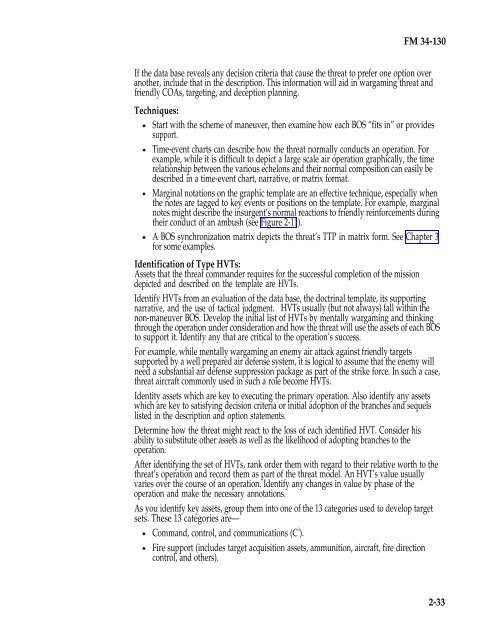Intelligence Preparation of the Battlefield - Federation of American ...
Intelligence Preparation of the Battlefield - Federation of American ...
Intelligence Preparation of the Battlefield - Federation of American ...
You also want an ePaper? Increase the reach of your titles
YUMPU automatically turns print PDFs into web optimized ePapers that Google loves.
FM 34-130<br />
If <strong>the</strong> data base reveals any decision criteria that cause <strong>the</strong> threat to prefer one option over<br />
ano<strong>the</strong>r, include that in <strong>the</strong> description. This information will aid in wargaming threat and<br />
friendly COAs, targeting, and deception planning.<br />
Techniques:<br />
Start with <strong>the</strong> scheme <strong>of</strong> maneuver, <strong>the</strong>n examine how each BOS “fits in” or provides<br />
support.<br />
Time-event charts can describe how <strong>the</strong> threat normally conducts an operation. For<br />
example, while it is difficult to depict a large scale air operation graphically, <strong>the</strong> time<br />
relationship between <strong>the</strong> various echelons and <strong>the</strong>ir normal composition can easily be<br />
described in a time-event chart, narrative, or matrix format.<br />
Marginal notations on <strong>the</strong> graphic template are an effective technique, especially when<br />
<strong>the</strong> notes are tagged to key events or positions on <strong>the</strong> template. For example, marginal<br />
notes might describe <strong>the</strong> insurgent’s normal reactions to friendly reinforcements during<br />
<strong>the</strong>ir conduct <strong>of</strong> an ambush (see Figure 2-11).<br />
A BOS synchronization matrix depicts <strong>the</strong> threat’s TTP in matrix form. See Chapter 3<br />
for some examples.<br />
Identification <strong>of</strong> Type HVTs:<br />
Assets that <strong>the</strong> threat commander requires for <strong>the</strong> successful completion <strong>of</strong> <strong>the</strong> mission<br />
depicted and described on <strong>the</strong> template are HVTs.<br />
Identify HVTs from an evaluation <strong>of</strong> <strong>the</strong> data base, <strong>the</strong> doctrinal template, its supporting<br />
narrative, and <strong>the</strong> use <strong>of</strong> tactical judgment. HVTs usually (but not always) fall within <strong>the</strong><br />
non-maneuver BOS. Develop <strong>the</strong> initial list <strong>of</strong> HVTs by mentally wargaming and thinking<br />
through <strong>the</strong> operation under consideration and how <strong>the</strong> threat will use <strong>the</strong> assets <strong>of</strong> each BOS<br />
to support it. Identify any that are critical to <strong>the</strong> operation’s success.<br />
For example, while mentally wargaming an enemy air attack against friendly targets<br />
supported by a well prepared air defense system, it is logical to assume that <strong>the</strong> enemy will<br />
need a substantial air defense suppression package as part <strong>of</strong> <strong>the</strong> strike force. In such a case,<br />
threat aircraft commonly used in such a role become HVTs.<br />
Identity assets which are key to executing <strong>the</strong> primary operation. Also identify any assets<br />
which are key to satisfying decision criteria or initial adoption <strong>of</strong> <strong>the</strong> branches and sequels<br />
listed in <strong>the</strong> description and option statements.<br />
Determine how <strong>the</strong> threat might react to <strong>the</strong> loss <strong>of</strong> each identified HVT. Consider his<br />
ability to substitute o<strong>the</strong>r assets as well as <strong>the</strong> likelihood <strong>of</strong> adopting branches to <strong>the</strong><br />
operation.<br />
After identifying <strong>the</strong> set <strong>of</strong> HVTs, rank order <strong>the</strong>m with regard to <strong>the</strong>ir relative worth to <strong>the</strong><br />
threat’s operation and record <strong>the</strong>m as part <strong>of</strong> <strong>the</strong> threat model. An HVT’s value usually<br />
varies over <strong>the</strong> course <strong>of</strong> an operation. Identify any changes in value by phase <strong>of</strong> <strong>the</strong><br />
operation and make <strong>the</strong> necessary annotations.<br />
As you identify key assets, group <strong>the</strong>m into one <strong>of</strong> <strong>the</strong> 13 categories used to develop target<br />
sets. These 13 categories are—<br />
Command, control, and communications (C 3<br />
).<br />
Fire support (includes target acquisition assets, ammunition, aircraft, fire direction<br />
control, and o<strong>the</strong>rs).<br />
2-33
















